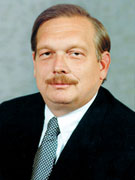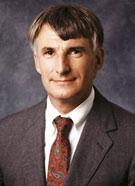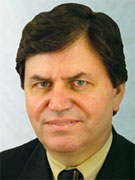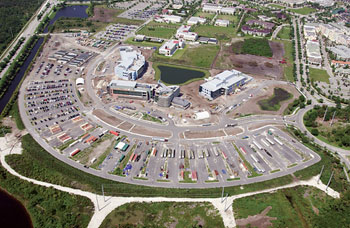hether it’s $1 billion in Massachusetts, hundreds of millions of dollars in Florida or a proposed $1.1 billion in Maryland, states and counties are unleashing their coffers with a variety of packages to boost their regional biotechnology sectors.
Brilliant strategies to build up a lucrative industry clusters, or a potential drain on taxpayers? Critics of state investments in biotechnology say these investments don’t always pay off, particularly if research efforts fail. The argument goes that executives and star scientists come and go, but the taxpayers get stuck with the bill over a period of many years.
Speaking to the critics at June’s Biotechnology Industry Organization International Convention in San Diego – BIO for short – Massachusetts Gov. Deval Patrick said it was important to be “prudent and cautious, but we also don’t want to be stuck. The economy is cyclical. There will be a recovery. And we better be positioning ourselves to take advantage of that growth when it comes.” Only a few days earlier Patrick had signed into law legislation that included $250 million in tax incentives for companies;

$250 million in grants and $500 million for infrastructure, much of which was earmarked for the state university system.
Former Florida Gov. Jeb Bush, speaking at the same program, said tax incentives allowed Florida to “get in the game.” Bush was governor at a time when his state directed about half a billion dollars of surplus money into bioscience, including creating financial incentives that allowed a number of research institutes to open there.
But in the scramble to bolster their biotech clusters, experts warn states and regions that there’s more to staying competitive than tossing out money and incentive plans. What matters in the long run, they say, is applying the right package of incentives in a strategic fashion – whether they include matching grants, direct funding of university research, corporate tax credits or seed money for start-up companies, to name some examples.
Walter Plosila, senior advisor to the technology partnership practice at the Battelle Memorial Institute just outside of Cleveland, Ohio, says localities want to avoid engaging in the “smokestack chasing” that has historically taken place in industries from automobiles to aerospace, where the emphasis is on luring companies from other regions, rather than building from within. He thinks state or regional investments are most positive when applied to state backing of university bioscience research,

investments in intellectual property through tax credits or providing “pre-seed” capital for biotech startups
Things can get out of hand, he says, when “unsophisticated localities hire consultants, including lawyers, to sell the incentive game. The locality starts to think they have to offer incentives for everyone.” He warns cities and regions to be careful about using local property taxes – used to fund public schools – as an incentive. In the long run, the locality will lose the funding required to build a talent base to lure bioscience companies to its region, he said.
J. Mike Bowman does see effective use of tax incentives and state investment in the life sciences, but warns that “just spending money doesn’t work.” Bowman is both chairman and president of the Delaware Technology Park Incorporated in Newark, Del. and president of the Association for University Research Parks (AURP).
Speaking from an AURP perspective, he said positive outcomes “will depend on the expertise of those handing out the money and what life sciences means for that area. If you are convinced that that the life sciences are beneficial to an area and augment its strengths, then one might look at business plans to develop a credible growth rate and explore what financing, outside of incentives, are provided,” he explained.
Like Plosila, Bowman doesn’t support states or regions creating “an auction atmosphere,” or using of incentives “to get a company to move 20 miles. That’s counter-regional and destructive.” Nor does he believe in looking over his shoulder to outspend other regions. By building regional networks and incrementally building up their biotech industry, Bowman said Delaware has won its “fair share without bartering for everything.”
He does believe providing tax credits to qualified angel investors and entrepreneurs who provide seed money for companies is a productive use of taxpayer money. “I think they deserve a tax credit as they won’t make money going into the company; they don’t get their fair due for taking a risk,” he explained.
However, he says no amount of money or incentives can make a difference when there isn’t a critical mass of talent, a location is wrong, transportation infrastructure is lacking or business people aren’t behind a project. This was the case about 20 years ago when Delaware economic development officials tried to locate a research park on “a wonderful location near the beach.” But Bowman points out that people don’t do business “with tourists on the beach.” The idea of building a biotech park at this site was dead by 2000, he said.
By 2002, however, Delaware was able to make investment in biotech pay off when it attracted the renowned German research organization Fraunhofer to a site adjacent to the University of Delaware campus in Newark. There the organization established the Fraunhofer Center For Molecular Biotechnology. Although Bowman said the state has invested approximately $10 million in Fraunhofer over the years – mainly in the form of matching grants to promote their scientific growth – he said he wouldn’t support this sort of investment without “job growth, extraordinary scientists and high-quality intellectual property being developed in premier space. That’s our criteria. If we provided funding for everything it wouldn’t matter very much.”
Fraunhofer has since taken over the entire building to develop vaccine from plants, effectively doubling its space. According to Bowman, who is a member of Fruanhofer’s American board of directors,

“It’s morphed from a few people to buying an entire building this year and moving into clinical trial material. The state made that happen through funding.”
Charles Craig, president of Georgia Bio in Atlanta, is also a firm believer in the proper investment in the biotech industry. Next year when the industry gathers for its BIO international convention the site will be Atlanta – a huge indicator to Craig that the state’s hundreds of millions of dollars of investment in biotech has paid off. Playing host to BIO “is a reflection of the enormous growth in Georgia’s life sciences industry,” he explained.
If still a small portion of Georgia’s overall economy, Craig says biotech is the fastest- growing industry in the state. This is thanks, in part, to 20 years of state investment in six major universities to boost “research strength, ” with many more millions devoted to create “bio seed” funds to help start-up companies commercialize research from these centers. According to Craig, Georgia has also created tax incentive programs designed to encourage investors to support the biotech industry. In many cases, industry matches are required.
The next focus, Craig says, is establishing an “education and work-force development strategy” for the Innovation Crescent – a 13-county region running from Atlanta to Athens that holds 80 percent of Georgia’s biotech industry. He would also like to see creation of a venture capital fund that would funnel at

least $200 million over the next 10 years to assist with commercialization of bioscience research “to support existing industry and grow more companies.”
Although he considers this sort of financing essential, and points to the fact that other states “are doing similar things,” Craig agrees that all state spending and use of incentives “has to be done in the context of a strategic plan and vision for the future.”
In Palm Beach County, Fla., which just committed $86.9 million in matching funds with the state to bring in the celebrated German Max Planck Society to town, County Commissioner Burt Aaronson acknowledged the financial strain of the deal. But he told the media he was “perfectly willing to do that because I believe in the long run that it’s going to be beneficial.”
So far, investments of this magnitude appear to be paying off in Florida, where

Kelly Smallridge, president and CEO of the Business Development Board of Palm Beach County, says the state now boasts “nearly 600 biotech, pharmaceutical and medical-device companies.” Florida officials like Smallridge believe the millions it took to encourage The Scripps Research Institute (TSRI) of La Jolla, Calif., to set up a second center in Palm Beach in 2003 has been worth the expense.
The Torrey Pines Institute for Molecular Studies and Burnham Institute for Medical Research followed suit and, according to news reports, large pharmaceuticals have taken notice. For example, Merck & Co. is establishing a for-profit research venture with H. Lee Moffitt Cancer Center & Research Institute of Tampa.
Citing the coup of recruiting the Max Planck Society from Germany to create their first U.S. operation, Smallridge says the world’s “largest non-university institute” is bringing three divisions to Palm Beach County – bio sensing, bio imaging, and cellular mechanisms – to be located next to the Scripps Research Institute, in the north part of Palm Beach County. Without investment from the state, she said, Florida would not have attracted these sorts of non-profit institutes, which lack money to purchase land and build infrastructure.
Richard Lerner, Scripps Research Institute President, concurs. He recently told the press that without incentive packages, institutes like his “will stay away.”